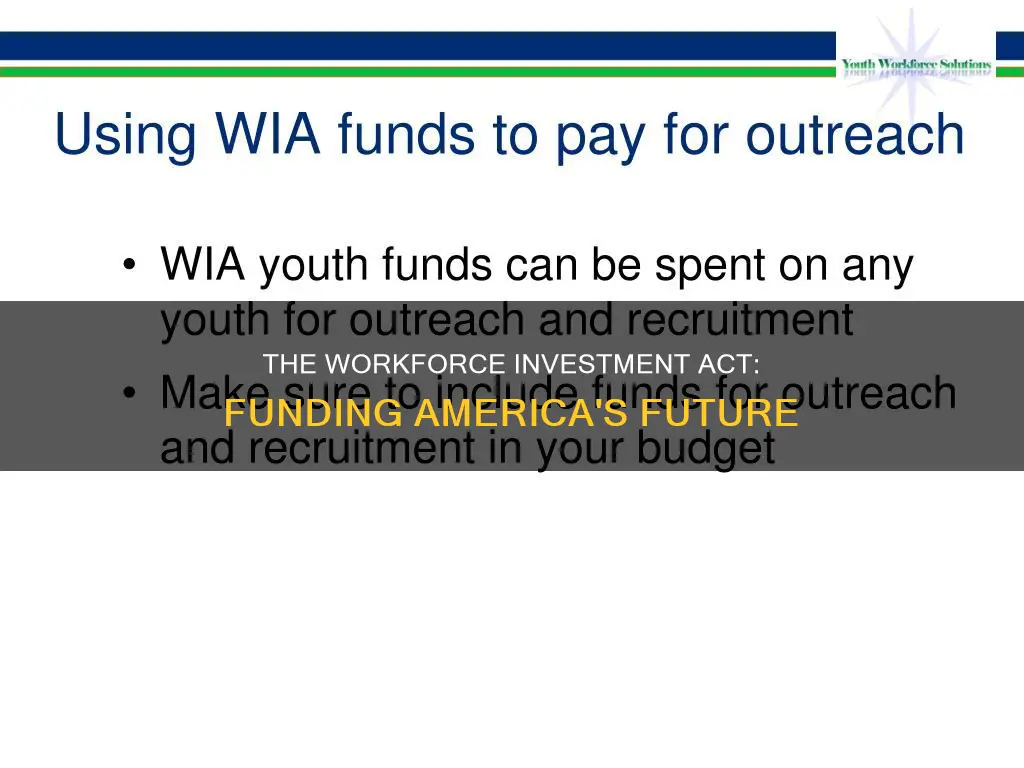
The Workforce Investment Act of 1998 was a United States federal law that was repealed and replaced by the 2014 Workforce Innovation and Opportunity Act. The Act provided funding for workforce investment activities that aimed to increase employment, retention, and earnings, as well as occupational skill attainment, to improve the quality of the workforce, reduce welfare dependency, and enhance the nation's productivity and competitiveness. The Act supported employment and training services to help eligible individuals find meaningful employment and assist employers in finding skilled workers. Additionally, it promoted literacy initiatives to ensure adults achieved a minimum 8th-grade reading level before entering the workforce. The Act also authorised state and local workforce investment boards, with a focus on measuring the success of participants.
| Characteristics | Values |
|---|---|
| Purpose | To improve the public workforce system with education and economic development to create a collective response to economic and labor market challenges on the national, state, and local levels |
| Target Group | Job seekers, including youth and those with significant barriers to employment |
| Services Provided | Access to employment, education, training, and support services to succeed in the labor market |
| Replaced | Job Training Partnership Act and certain other Federal and job training laws |
| Enacted | August 7, 1998 |
| Replaced By | Workforce Innovation and Opportunity Act in 2014 |
What You'll Learn

Adult and Dislocated Worker Program
The Adult and Dislocated Worker Program, established under Title I of the Workforce Investment Act of 1998 and reauthorized in 2014 under the Workforce Innovation and Opportunity Act (WIOA), provides employment and training services to eligible individuals to help them find and qualify for meaningful employment. The program also helps employers find skilled workers to compete and succeed in business.
Eligibility:
To qualify for the Adult and Dislocated Worker Program, individuals must be 18 years of age or older or be a dislocated worker. Dislocated workers are those who have become unemployed due to job loss, mass layoffs, global trade dynamics, or transitions in economic sectors.
Services Offered:
The program offers a range of services, including job search assistance, training opportunities, career counselling, and supportive services. Training services may include occupational skills training, on-the-job training, incumbent worker training, entrepreneurial training, and adult education and literacy activities.
Funding:
The WIOA program is funded by the Department of Labor and administered by each state through local workforce systems. The program does not charge any fees to eligible participants. In some cases, if an individual is eligible for financial aid, it will be applied to training first, and WIOA will pay the remaining balance.
Application Process:
Individuals interested in the Adult and Dislocated Worker Program can apply through a WIOA pre-screening application or by contacting their local American Job Center. The enrollment process can be quick, and eligibility can be determined in as little as 10 business days if all supporting documents are provided.
Performance Evaluation:
The U.S. Department of Labor's Employment and Training Administration commissioned a national evaluation of the effectiveness of the Adult and Dislocated Worker programs. The evaluation found that intensive services, such as staff assistance, provided by the programs were effective in increasing earnings for participants. However, the evidence on the impact of training funded by the programs was inconclusive.
The Debt Dilemma: Pay Off in Full or Invest?
You may want to see also

Funding for Native Americans
The Workforce Investment Act of 1998 (WIA) was a United States federal law that was repealed and replaced by the 2014 Workforce Innovation and Opportunity Act (WIOA). The WIA was enacted to replace the Job Training Partnership Act and certain other federal job training laws with new workforce investment systems. The WIA's main goal was to create a system that provides a means to increase employment, retention, and earnings of individuals.
The WIOA is designed to help job seekers access employment, education, training, and support services to succeed in the labor market and to match employers with skilled workers. The WIOA also provides funding for Native American programs. The Division of Indian and Native American Programs (DINAP) WIOA Section 166 grantees and the Department of Labor share a vision of providing quality employment and training services to tribes, tribal organizations, Alaska Native entities, Indian-controlled organizations, and Native Hawaiian organizations serving unemployed and low-income Native Americans, Alaska Natives, and Native Hawaiians.
The Section 166 programs are designed to support employment and training activities to develop the academic, occupational, and literacy skills of individuals, making them more competitive in the workforce and promoting economic and social development. These programs are administered in a way that meets regulatory requirements and aligns with the traditional cultural values and beliefs of the communities they serve.
The Bureau of Indian Affairs (BIA) also manages the Financial Assistance and Social Services (FASS) program, which provides financial aid to tribal members who cannot access welfare or Temporary Assistance for Needy Families (TANF). Qualified members may receive money for general needs, emergencies, adult care, and burial costs.
Additionally, the WIOA provides funding for American Job Centers, which offer a range of services, including skills training grants, trade adjustment assistance, and unemployment insurance. These services are available to all job seekers, including Native Americans, to help them succeed in the labor market and find high-quality jobs.
C-Corp: Why Investors Choose This Structure
You may want to see also

Job Corps
The Workforce Investment Act of 1998 (WIA) is a federal act that provides workforce investment activities through statewide and local workforce investment systems. The act aims to increase employment, retention, and earnings of participants, as well as increase occupational skill attainment, improve the quality of the workforce, reduce welfare dependency, and enhance the productivity and competitiveness of the nation.
To be eligible to participate in Job Corps, an individual must be between the ages of 16 and 24 at the time of enrollment, be a low-income individual, and be facing one or more barriers to education and employment, such as basic skills deficiency, homelessness, or the need for additional education or vocational training.
In addition to providing funding for Job Corps, the WIA also establishes requirements and guidelines for the program, including eligibility criteria, center operations, and performance assessment. The act specifies the roles and responsibilities of various entities involved in the program, including the Job Corps Director, center operators, outreach and admissions agencies, and placement agencies. The act also outlines the process for selecting entities to receive funding to operate centers and provide training and operational support services, with a focus on coordinating activities with state and local workforce investment plans and offering training that reflects local employment opportunities.
Renewable Energy: Our Future's Investment
You may want to see also

Youth Opportunity Grants
The Workforce Investment Act of 1998 was a United States federal law that was repealed and replaced by the 2014 Workforce Innovation and Opportunity Act. The main goal of the WIA was to create a system that provides a means to increase employment, retention, and earnings of individuals. This was achieved by increasing occupational skill attainment by participants, improving the quality of the workforce, reducing welfare dependency, and enhancing the productivity and competitiveness of the nation.
The WIA is split into five titles that outline how the WIA accomplishes its goal. Title one of the Act authorises state and local workforce investment boards and requires the use of certain standards for success. It also authorises a one-stop delivery system, allowing participants to access both job training and referrals in their local area.
Under the WIA, the Secretary of Labor is directed to make Youth Opportunity Grants to eligible local partnerships to provide specified activities to increase the long-term employment of eligible youth who live in empowerment zones, enterprise communities, and high-poverty areas. These grants are designed to increase the employment, retention, and earnings of youth, as well as increase their occupational skill attainment, ultimately improving the quality of the workforce.
The Youth Opportunity Grants are just one example of grants that aim to support youth in finding employment and education pathways. The Opportunity Youth Incentive Fund, established by the Aspen Institute Forum for Community Solutions, is another example. This fund supports cross-sector collaboration to bring young Americans back into education and the workforce. The fund makes an initial $6 million commitment and awards grants of up to $500,000 to collaboratives that harness the power of cross-sector collaboration to make substantive progress for opportunity youth, defined as young people aged 16-24 who are disconnected from education and work.
VOO: Invest Now or Later?
You may want to see also

National Emergency Grants
The Workforce Investment Act of 1998 (WIA) was a United States federal law that was repealed and replaced by the 2014 Workforce Innovation and Opportunity Act. The Act provided funding for workforce investment activities that aimed to increase employment, retention, earnings, and occupational skill attainment. It also sought to reduce welfare dependency and enhance the nation's productivity and competitiveness.
The grants are designed to provide adjustment assistance to eligible dislocated workers, including core, intensive, and training services. They also offer supportive services to help workers participate in training programs and enable them to receive needs-related payments. In the case of a declared emergency or natural disaster, the grants can provide short-term disaster relief employment for laid-off workers, dislocated workers, and the long-term unemployed.
The Secretary of Labor awards two types of National Emergency Grants: Disaster Recovery and Employment Recovery. Disaster Recovery grants provide funding for temporary employment opportunities in clean-up and recovery efforts following a federally recognized disaster. Employment Recovery grants temporarily expand capacity to serve dislocated workers and meet increased demand for employment and training services after events like major economic dislocations or mass layoffs.
Rights: A CMO Investor's Guide
You may want to see also
Frequently asked questions
The purpose of the Workforce Investment Act is to improve the public workforce system with education and economic development to create a collective response to economic and labour market challenges on the national, state, and local levels.
The Act provides funding for workforce investment activities that increase employment, retention, and earnings of participants, and increase occupational skill attainment.
The Act targets job seekers, including youth and those with significant barriers to employment, to help them access education, employment, and training. It also helps employers hire and retain skilled workers.
The Act provides job seekers with support services to succeed in the labour market, including academic training, rehabilitation services, and grants for recreational programs.
Each state receives a different amount of funding based on its population size. For example, Utah gets $1.5 million per year, while larger states like California have a bigger budget that is distributed to local boards.







